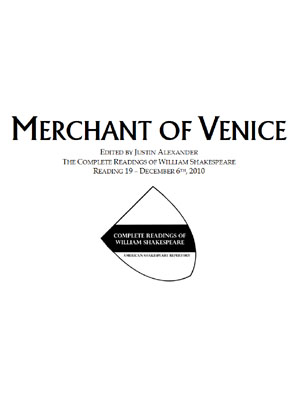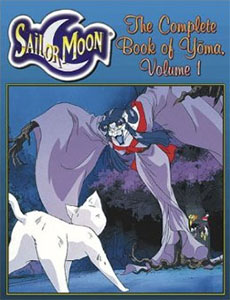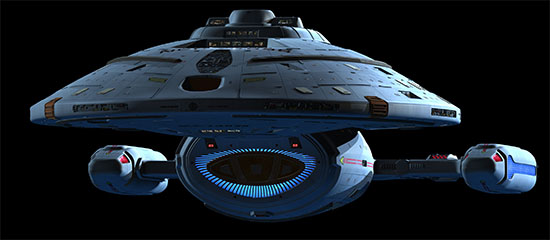 In the original text for The Merchant of Venice there are, arguably, four different characters with similar names: Salanio, Solanio, Salarino, and Salerio. (Salarino is also spelled Salaryno, but that’s a fairly self-evident variant.) The Second Quarto in 1619 changed all the instances of “Solanio” to read “Salanio”, and since the Q2 text was preferred for the next few centuries most modern editions still follow this practice and narrow the list to Salanio, Salarino, and Salerio.
In the original text for The Merchant of Venice there are, arguably, four different characters with similar names: Salanio, Solanio, Salarino, and Salerio. (Salarino is also spelled Salaryno, but that’s a fairly self-evident variant.) The Second Quarto in 1619 changed all the instances of “Solanio” to read “Salanio”, and since the Q2 text was preferred for the next few centuries most modern editions still follow this practice and narrow the list to Salanio, Salarino, and Salerio.
John Dover Wilson referred to these character as the “Three Sallies” in his efforts to unravel the rather vague identities of these characters for the New Shakespeare edition of the play. My own work on the Q1 text confirmed that his conclusions were generally sound, and the ASR script for The Merchant of Venice generally follows his practices.
First, there is the character of Salanio/Solanio. This character first appears in 1.1 and is identified in the first stage direction and speech heading as “Salanio”. But the character is then referred to consistently as “Sola.” in the remaining speech headings and then “Solanio” in the stage direction for his exit. Similarly, in his next appearance in 2.4, the character is identified as “Salanio” in the first stage direction before becoming “Solanio” in the first speech heading and then “Sol” for the rest of them. In 2.8 the character is “Solanio”, “Sola”, and “Sol”. And, finally, in 3.1 he is “Solanio”, “Solan”, “Sola”, and then “Solanio” again.
In the balance, I am forced to agree with John Dover Wilson that the text’s overwhelming preference for “Solanio” would be respected by more modern editors if the 1619 quarto hadn’t arbitrarily corrected the name to the form of its first, irregular spelling.
In the ASR script, therefore, the character is “Solanio”.
Second, there is the character of Salarino/Salerio. As “Salaryno” the character appears in the first stage direction in 1.1, then as “Salarino” in his first speech heading. He then becomes “Salar” once, “Sala” once, “Sal” once, and then “Salarino” for his exit. In 2.4 he is “Salaryno” once again for his entrance, “Salari” once, and then “Sal” for the rest of his speech headings. (It is notable that the distinction between “Sol” for Solanio and “Sal” for Salarino/Salerio in these scenes requires the spelling of “Solanio” and not “Salanio”.) In 2.8, he is once again “Salarino” in the stage direction and then “Sal” in all speech headings. In 3.1, he remains “Salarino” in the stage directions but becomes “Salari” for all speech headings.
At this point, both Solanio and Salarino disappear from the play. They are replaced by a completely new character named “Salerio” who shows up in Belmont for 3.2 (“Sal” in speech headings), teleports back to Venice for 3.3 (“Sal” and “Sol” in speech headings), and then appears in the courtroom in 4.1 (where he’s given no entrance, but is referred to as “Salerio” in both his speech headings).
John Dover Wilson argues that “Salerio” must be either Solanio or Salarino, and I’m forced to agree: It makes little sense for the other two characters to simply disappear from the play while being replaced by a third character out of wholecloth. The most likely error is that “Salerio” and “Salerino” should be the same character, misread by the compositors of Q1. Between the two, Wilson argues that “Salerio” must be the correct form because (a) it is the only form found in actual dialogue and (b) it matches scansion in the dialogue where it does appear while “Salarino” does not. (This, to my eye, appears to be a little loose. But it is true that “Salerio” matches the scansion perfectly in most cases and acceptably in the rest, whereas “Salarino” causes far more problems if you choose it.)
But the reality of the situation is more complicated than that, because it appears that Salerio’s appearance in 3.3 is a completely different error: First, he leaves Belmont with Bassanio and Gratiano at the end of 3.2, so it makes little sense that he has somehow gotten back to Venice ahead of the others without mentioning their approach to Anthonio. Second, his appearance would require an exit at the end of 3.2 and then an immediate re-entrance at the beginning of 3.3 (a practice Shakespeare never engages in for obvious reasons). Finally, the character’s identity is somewhat confused in any case: In the Q1 text he appears as “Salerio” in the stage direction, “Sol” in his first speech heading, and then “Sal” in his second speech heading.
The Q2 compositors apparently recognized the problem and corrected the character to “Salarino”. But since Salarino and Salerio are the same character, this obviously doesn’t solve the problem. The First Folio, on the other hand, correctly changes the character’s name to Solanio.
Taking all of that into consideration, therefore, we take our Four Sallies and reduce them to two: “Salanio” and “Solanio” are both Solanio. “Salarino”, “Salaryno”, and “Salerio” are all Salerio (except for 3.3, where Solanio is restored to his proper place).
Go to Merchant of Venice: The Script.
Originally posted on December 7th, 2010.

 The Complete Book of Yoma: Volume 1
The Complete Book of Yoma: Volume 1










